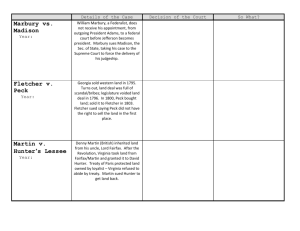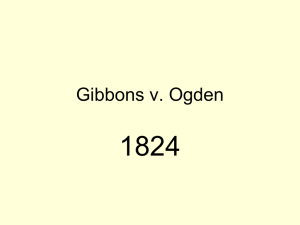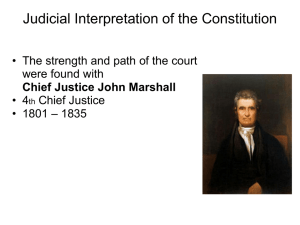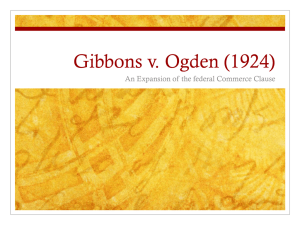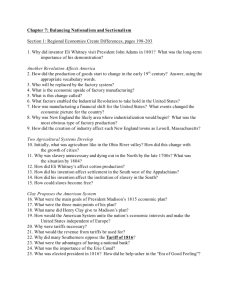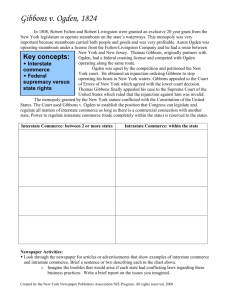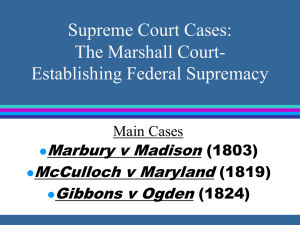The Marshall Court
advertisement
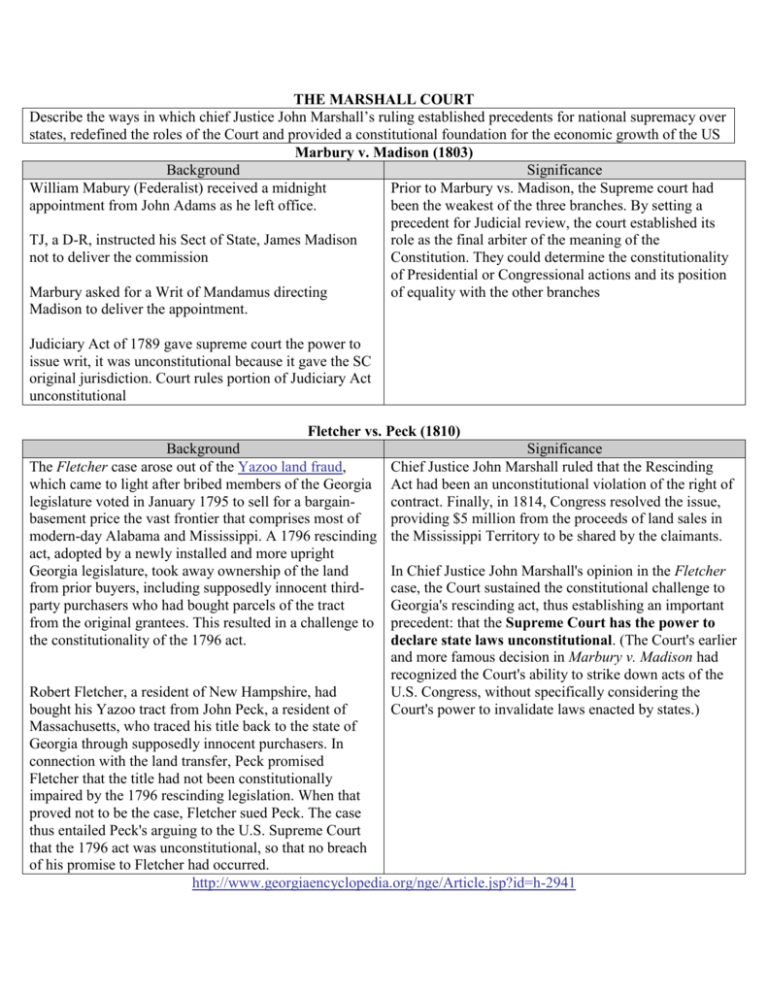
THE MARSHALL COURT Describe the ways in which chief Justice John Marshall’s ruling established precedents for national supremacy over states, redefined the roles of the Court and provided a constitutional foundation for the economic growth of the US Marbury v. Madison (1803) Background Significance William Mabury (Federalist) received a midnight Prior to Marbury vs. Madison, the Supreme court had appointment from John Adams as he left office. been the weakest of the three branches. By setting a precedent for Judicial review, the court established its TJ, a D-R, instructed his Sect of State, James Madison role as the final arbiter of the meaning of the not to deliver the commission Constitution. They could determine the constitutionality of Presidential or Congressional actions and its position Marbury asked for a Writ of Mandamus directing of equality with the other branches Madison to deliver the appointment. Judiciary Act of 1789 gave supreme court the power to issue writ, it was unconstitutional because it gave the SC original jurisdiction. Court rules portion of Judiciary Act unconstitutional Fletcher vs. Peck (1810) Background The Fletcher case arose out of the Yazoo land fraud, which came to light after bribed members of the Georgia legislature voted in January 1795 to sell for a bargainbasement price the vast frontier that comprises most of modern-day Alabama and Mississippi. A 1796 rescinding act, adopted by a newly installed and more upright Georgia legislature, took away ownership of the land from prior buyers, including supposedly innocent thirdparty purchasers who had bought parcels of the tract from the original grantees. This resulted in a challenge to the constitutionality of the 1796 act. Significance Chief Justice John Marshall ruled that the Rescinding Act had been an unconstitutional violation of the right of contract. Finally, in 1814, Congress resolved the issue, providing $5 million from the proceeds of land sales in the Mississippi Territory to be shared by the claimants. In Chief Justice John Marshall's opinion in the Fletcher case, the Court sustained the constitutional challenge to Georgia's rescinding act, thus establishing an important precedent: that the Supreme Court has the power to declare state laws unconstitutional. (The Court's earlier and more famous decision in Marbury v. Madison had recognized the Court's ability to strike down acts of the U.S. Congress, without specifically considering the Court's power to invalidate laws enacted by states.) Robert Fletcher, a resident of New Hampshire, had bought his Yazoo tract from John Peck, a resident of Massachusetts, who traced his title back to the state of Georgia through supposedly innocent purchasers. In connection with the land transfer, Peck promised Fletcher that the title had not been constitutionally impaired by the 1796 rescinding legislation. When that proved not to be the case, Fletcher sued Peck. The case thus entailed Peck's arguing to the U.S. Supreme Court that the 1796 act was unconstitutional, so that no breach of his promise to Fletcher had occurred. http://www.georgiaencyclopedia.org/nge/Article.jsp?id=h-2941 Martin v. Hunter's Lessee (1816) Background Significance Lord Fairfax held land in Virginia. He was a Loyalist and assert ultimate Supreme Court authority over state courts fled to England during the Revolution. He died in 1781 in matters of federal law. and left the land to his nephew, Denny Martin, who was a British subject. The following year, the Virginia The Court rejected the claim that Virginia and the legislature voided the original land grant and transferred national government were equal sovereigns. Reasoning the land back to Virginia. Virginia granted a portion of from the Constitution, Justice Story affirmed the Court's this land to David Hunter. The Jay Treaty seemed to power to override state courts to secure a uniform system make clear that Lord Fairfax was entitled to the property. of law and to fulfill the mandate of the Supremacy The Supreme Court declared that Fairfax was so entitled, Clause. but the Virginia courts, where the suit arose, refused to follow the Supreme Court's decision. McCulloch vs. Maryland (1819) Background Significance The BUS was established in 1791. Republicans argued The decision sanctioned the Federal government’s use of the bank was unconstitutional because the “elastic the implied powers (use of the e clause), established the clause” was used to create it. supremacy of the national government over the states, and paved the way for expansion of federal power After the BUS was re-chartered in 1816 several states ( (Congress, not the states has the power to make changes) including Maryland) put restrictions and taxes on the BUS within their states, When the cashier refused to pay the tax Maryland sued. The court ruled that only the federal government had the power to do what was “necessary and proper” to carry out their powers. Dartmouth College vs. Woodward (1819) Background Significance Dartmouth College was chartered in 1769 as a private The decision upheld the sanctity of contracts and of school. When members of its board sought to have the private property. The decision as important in assuring state legislature convert the school to a state university, economic development and encouraging investment in Federalist members of the school’s board of trustees new corporations. In addition, it set a precedent for the argued that the charter was a contract and the federal Supreme Court’s overturning of state laws ( through constitution forbade states from voiding the obligations Fletcher v. Peck 1810, the court ruled a Georgia law of contracts. invalid. Federalists sued William Woodward (new trustee) and asked Daniel Webster to appeal their case. The court ruled that the state had no right to impair or invalidate the contract that made DC private. Gibbons vs. Ogden (1824) Background The case of Gibbons v. Ogden (1824), decided 35 years after the ratification of the Constitution, was a key turning point for the expansion of federal power to address national problems. Significance The power to regulate interstate commerce (trade) rests solely with the federal government, thus impeding the states from impeding trade. The Commerce Clause Article 1 Section 8 states that Congress has the power "[t]o regulate Commerce with foreign Nations, and among the several States. . . ." The hope was that giving Congress such a power would help to unify commerce policies thereby making market exchanges more efficient and less costly. States Rights supporters wanted to overturn protected monopolies (controlled by the rich)and encourage competition and the accumulation of wealth by more people New York granted Robert Fulton a long term monopoly Of steam navigation on the waters between NY and NJ. Aaron Ogden held a Fulton-Livingston license to operate steamboats under this monopoly. Previously Gibbons had obtained a congressional permit to operate a steamboat line in the same waters. Gibbons sued Ogden, as a licensee under Fulton’s steamboat company, had a monopoly of the waterways between NY and NJ. The Supreme Court ruled the monopoly granted to Ogden by NY was unconstitutional. Many wanted the court to rule in favor of the congressional authority to encourage support of public works projects (roads, bridges, and canals) That would contribute to the development of business and industry. The Court ruled in favor of Gibbons and some state’s rights activists feared the national government could now strike down the slave trade. Gibbons v. Ogden remains a strong instrument for federal government regulation within and among states TIMELINE 1808- NY state grants Robert Livingston and Robert Fulton, or their heirs as thirty year monopoly to operate steamboats on the waterways of the state and on contiguous coastal waters 1815- Livingston and Fulton are dead, and the inheritors of the company controlled their potential and actual rivals, such as Aaron Ogden and Thomas Gibbons by selling them rights to them to operate steamboats in NY/NJ Ogden and Gibbons become partners and acquire a license to be the sole steamboat transporter. 1818- Gibbons- Ogden partnership is ended and they become bitter rivals. Ogden begins losing passengers and profits to Gibbons (and Vanderbuilt) 1819 – Ogden charged that Gibbons was unlawfully operating an unlicensed steamboat and successfully sued him to stop. 1820 – NYS grants a permanent injunction against Gibbons. Gibbons (defended by Daniel Webster) appeals to the Supreme Court. Gibbons claims he has a right to navigate waters because of the 1793 Coasting Act, superseding state law and the commerce clause gave on Congress power to regulate interstate commerce.
